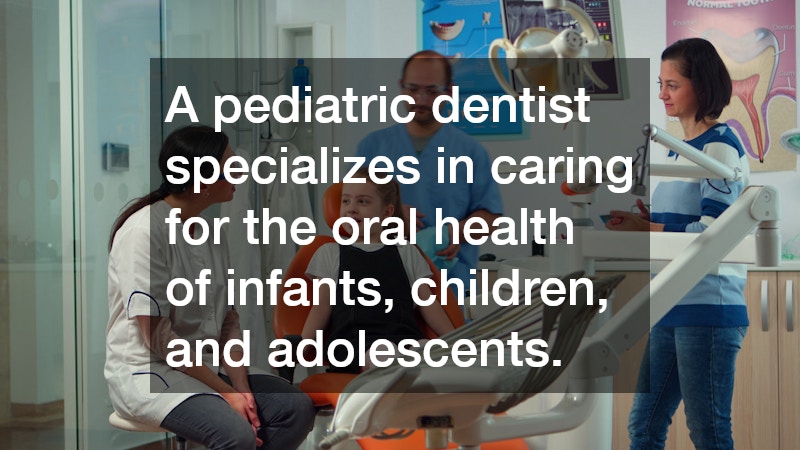Taking your child to the pediatric dentist for the first time is an important milestone in their journey toward lifelong oral health. Early dental visits not only help prevent tooth decay and gum disease but also establish a positive relationship between your child and dental care. Understanding what to expect during the first appointment can ease anxiety for both parent and child, setting the foundation for healthy habits and confident smiles.
What is a Pediatric Dentist?
A pediatric dentist specializes in caring for the oral health of infants, children, and adolescents. Their focus goes beyond simply treating teeth—they are trained to manage the emotional and developmental needs of young patients while promoting preventive dental care from an early age.
Specialized Training
Unlike general dentists, pediatric dentists complete additional years of specialized training after dental school. This includes expertise in child psychology, growth and development, and treatment techniques designed to make dental care a comfortable experience for kids. They are also equipped to handle special needs patients, ensuring every child receives compassionate and appropriate care.
Age Range for Patients
Pediatric dentists typically see patients from infancy through their teenage years. The American Academy of Pediatric Dentistry recommends scheduling a child’s first visit by their first birthday or within six months after their first tooth erupts. Early visits allow the dentist to monitor dental development, spot potential problems early, and provide parents with guidance on proper oral care.
How to Prepare Your Child
Talk to your child about the visit in positive, simple terms. Explain that the pediatric dentist will count their teeth, look at their smile, and help keep their mouth healthy. Avoid using words like “hurt,” “shot,” or “drill.” Instead, focus on reassuring phrases such as “the dentist will help your teeth stay strong.”
Books and Resources
Children’s books and videos about visiting the dentist can make the experience familiar and fun. Titles like The Berenstain Bears Visit the Dentist or Peppa Pig: Dentist Trip introduce dental visits in a lighthearted way, helping reduce fear or uncertainty.
Practice Dental Hygiene at Home
Before the appointment, encourage daily brushing and flossing routines. Practice opening wide and counting teeth together so your child feels more comfortable during the actual exam. This reinforces the idea that dental care is a normal, positive part of everyday life.
Schedule Considerations
For the best experience, schedule the appointment when your child is well-rested and alert—usually in the morning. Avoid nap times or late afternoons when they may be tired or irritable. Keeping the day’s routine predictable also helps reduce anxiety.
What Happens During the Appointment?
The first visit to a pediatric dentist is typically brief and focuses on helping your child become comfortable in the dental chair. The goal is to create a positive first impression while checking for early signs of dental issues.
Initial Exam and Assessment
The dentist will gently examine your child’s teeth, gums, and jaw to ensure proper growth and detect any cavities or developmental concerns. They may also check the bite alignment and look for signs of habits like thumb-sucking or mouth breathing that could affect oral health.
Cleaning Procedures
Depending on your child’s age, a light cleaning may be performed to remove plaque or tartar buildup. The pediatric dentist or hygienist will demonstrate proper brushing techniques, using small, child-friendly tools that make the process comfortable and even fun.
Fluoride Treatment
Fluoride treatments are often recommended to strengthen enamel and protect against cavities. The fluoride is applied as a gel, foam, or varnish and takes only a few minutes. It’s a simple and effective way to prevent tooth decay in growing smiles.
Discussion of Findings
After the exam, the dentist will review findings with parents, explaining any issues that need attention. They’ll discuss diet, oral hygiene habits, and preventive care strategies tailored to your child’s needs. Parents are encouraged to ask questions about teething, thumb-sucking, and how to maintain healthy routines at home.
Follow-Up and Future Appointments
Regular visits are key to maintaining your child’s oral health and ensuring continued development.
Scheduling the Next Visit
Most children should visit the pediatric dentist every six months for checkups and cleanings. These appointments allow the dentist to monitor progress, apply fluoride, and catch any potential issues before they become serious.
Tracking Progress
Over time, your child’s dental records will document changes in tooth growth, bite alignment, and jaw development. This helps the dentist anticipate orthodontic needs or other treatments early, ensuring proactive rather than reactive care.
Building Lifelong Smiles with Pediatric Dental Care
Visiting a pediatric dentist is one of the most important steps parents can take to safeguard their child’s oral and overall health. Early and consistent care builds trust, reinforces positive dental habits, and prevents many future problems before they begin. By preparing your child for their first visit and maintaining regular checkups, you’re not just protecting their teeth—you’re setting them up for a lifetime of confident, healthy smiles.





